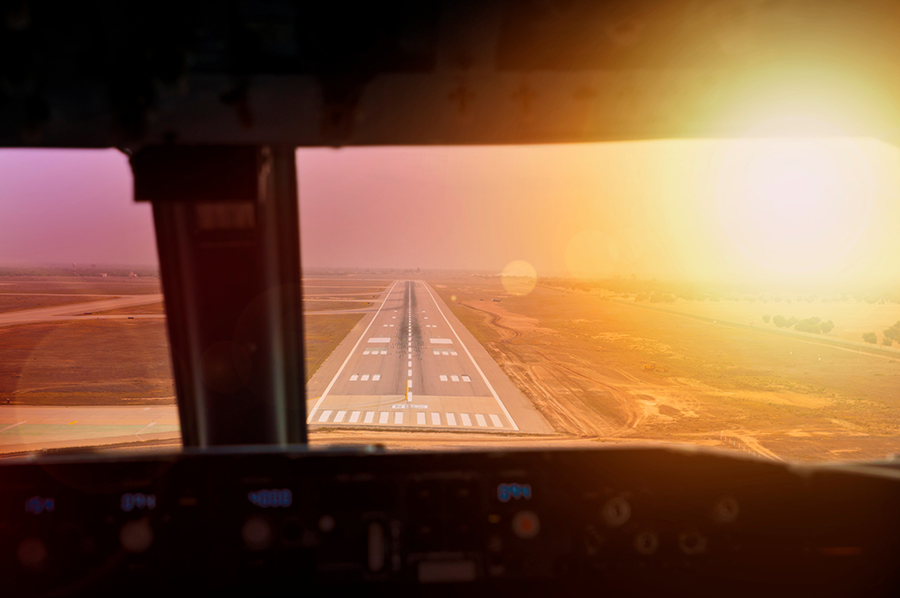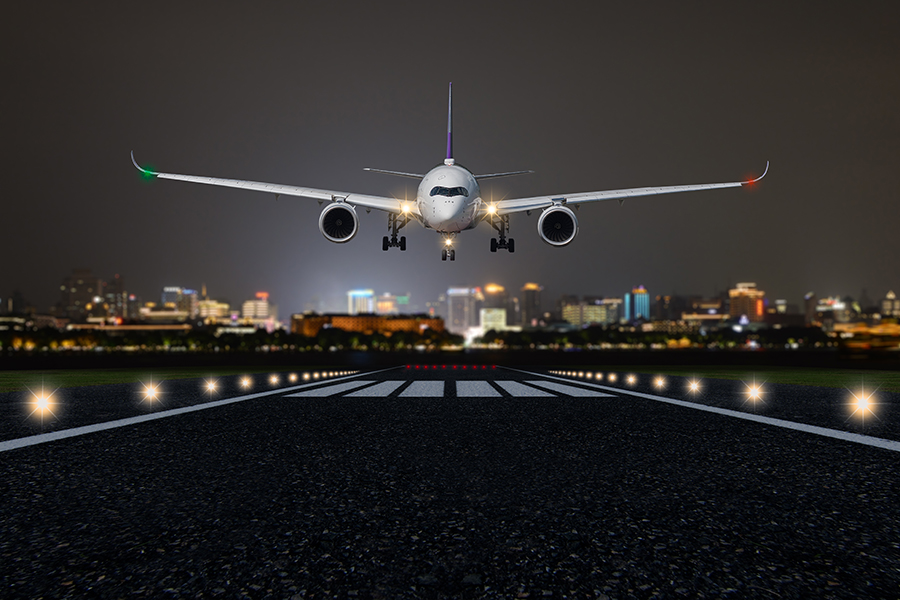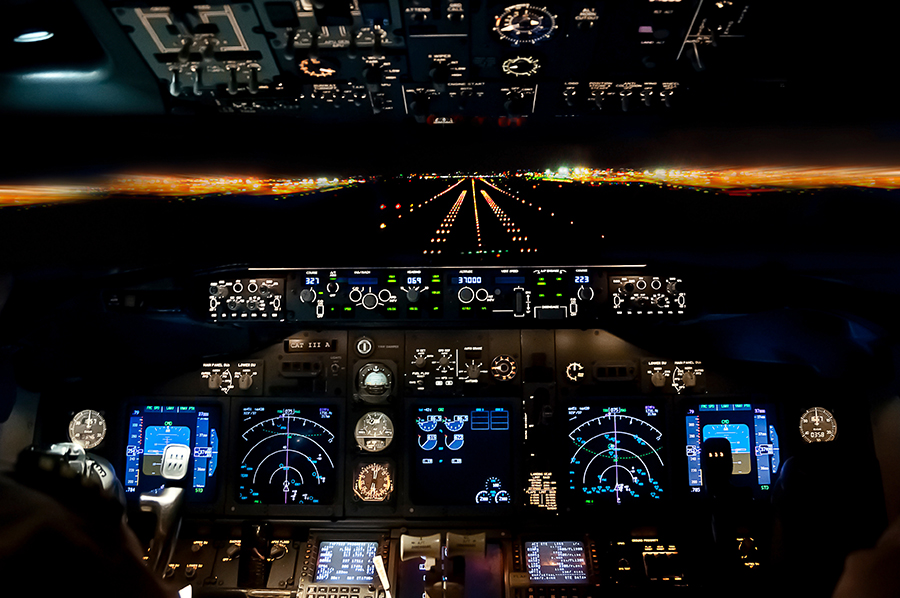

One question that is sure to vex most commercial pilots is, “the airplanes land themselves nowadays, don’t they?”. Can an airplane land itself? The true answer is it depends on many factors. Today we will look at autolands, explain how they work, why they are used, and when they are not. Here’s everything you need to know.
Takeoff is always achieved manually. However, depending on the aircraft type and airport approach facilities, they can be landed automatically using an instrument landing system coupled with onboard equipment. However, given a choice, most pilots prefer to perform a manual landing.
Well, there are several reasons why autoland is good. Still, there are also many significant downsides to an airplane landing itself.
In short, when performing an autoland, the pilot gives control over to the autopilot. While the autopilot is normally extremely reliable, at the end of the day, it is just a computer.
And here’s the thing…
Computers lack the decision-making skills and natural ‘feel’ that comes from having a human being in the controls.
Autolands tend to produce less ‘refined’ results in landing than a human operator. While autolands serve a valuable purpose, they are used reluctantly and with great caution in most circumstances.
The flight crew will mainly elect to perform an automatic landing during poor visibility conditions. This could include landing in phenomena such as the following: –
Generally, the aircraft autoland system is only used when visibility precludes a visual landing. While pilots are experts in following an instrument approach procedure, they still rely on visual references to perform the final landing stages.
These visual cues can be hard (and sometimes impossible) to see if the visibility is poor.
The autopilot can perform a ‘formulaic’ landing on any runway equipped with a suitably certified instrument landing system (commonly known as an ‘ILS’).
You can see an example of what the view is like from the flight deck in this quick video: –

Several pieces of equipment, both ground-based, and on the aircraft, are used to perform an automatic landing. Below, you’ll find an explanation of each and how it fits into the ‘bigger picture’ : –
The instrument landing system will give direction to the pilot, or autopilot, telling them which way to fly to be perfectly established on the extended runway centerline at the correct height.
Pilots will want to know how far away they are from touchdown. Distance measuring equipment (also called a DME). Displays this information, in nautical miles, in the flight deck.
DME is also useful to ensure the airplane is at the correct height at certain points along the glideslope. Pilots, during an autoland, will reference the distance vs. height constantly during an automatic approach to ensure no deviation.
The radio altimeter is a highly accurate piece of kit. A regular pressure altimeter will normally display altitude to the closest 10 feet. Radio altimeters are accurate to a single foot! This tells the pilots (and the autopilot) how far away the ground is.
During an automatic landing, the autopilot uses radio altimeter signals to tell it when to flare and when it has landed.
An automatic landing requires autopilot.
Most regulatory aviation bodies require some redundancy in the system, so it is normal for the aircraft to have two autopilots. In aviation, this is called a fail operational system… More about this a little later.
When flying in poor visibility, the last thing pilots need is to be trying to work out complex data presented by flight instruments. An easy way to display data is the use of flight directors.
In short, these easy-to-see command bars (normally presented on the attitude indicator) provide easy-to-interpret information, showing the commands the autopilot is receiving.
The truth is that it isn’t just anyone who can perform an autoland. Pilots must be trained on how to use the system and be autoland qualified (in fact, it is normally an additional endorsement on their license).
Flying close to the ground, in poor visibility, in a fast-moving aircraft can present all sorts of traps and pitfalls. Pilots who train to perform autolands will have completed a rigorous, simulator-based training program.
While the principles behind an automatic landing are generally the same, each aircraft type might use a slightly different interaction of systems to achieve a good outcome.
Some have audio calls that accompany visual signals. Some aircraft types use auto thrust, whereas others rely on pilots to control the speed. And some require the pilots to manually steer the aircraft once the wheels have touched the ground, whereas others, such as the airbus, do not.
If automatic landings are so failsafe and easy, why don’t pilots always use them?
Well, there are some very good reasons…

Autoland’s capability is great in a given set of circumstances. However, it is not always ideal in all circumstances. Here are the reasons why airplanes don’t always land themselves: –
Most pilots became pilots so they could actually fly the aircraft. Most of the time, the pilots will use autopilot during the cruise.
The only ‘stick and rudder’ time pilots of large commercial aircraft really get is during the takeoff and landing phases of the flight.
Using an autoland robs the pilots of this experience. You’ll tend to find that if a pilot can perform a manual landing, they will.
Automatic landings essentially give the aircraft controls over to a computer. Pilots want to make 110% sure that everything onboard is working.
There is a great deal of redundancy built into autoland technology. Generally, most systems used to make an automatic landing have a backup. If the backup systems are not operational, this can be limiting on whether the aircraft can perform an autoland.
It is only possible to automatically land at an airport equipped with a suitable ILS.
In short, no ILS, no automatic landing.
Due to the nature of automatic landings, even if an airport has an ILS, it must be tested and calibrated to ensure 100% reliability. According to the FAA, this must be completed every 540 days. And this is for each separate ILS on each runway. Depending on how much the airport is used, it may have an ILS, but it is only certified for use in marginally bad weather.
When an airplane is certified and approved, it goes through a rigorous testing process under the watchful eye of a test pilot.
In aviation, whether talking big jets or a small Cessna, you’ll often encounter the phrase ‘maximum demonstrated’… Particularly with regard to things like crosswind.
This means the weather conditions during the certification phase only allowed the test pilot to monitor certain limits regarding meteorological data. While airplanes might be able to perform an automatic landing in worse weather, insurers, and regulatory bodies will only approve their use up to a demonstrated limit.
And there is more…
Whereas a human pilot can think analytically ‘outside of the box’, an autopilot is simply a computer with a computer’s limitations. If a strong crosswind is beyond the limits of what the autopilot is programmed for, it can behave erratically. Not good when you are close to the ground in marginal weather.
Runway contamination, such as slush, snow, ice, or standing water, can be hazardous during an automatic landing. Most major airplane manufacturers will not approve of using the autoland system on contaminated runways.
Look at it like this.
Would you 100% trust the cruise control on your car while traveling at 170 miles per hour?
Nope, pilots, neither.
Autolands remove an element of control from the pilot. Essentially, you are putting your life and safety in the hands of a machine. While automatic landing is safe, pilots take no chances. The autopilot and onboard systems must be watched like a hawk down to a full stop on the runway.
This twinned with the strong possibility that conditions outside the aircraft rob the pilot of the usual visual cues. It is easy to see why those ‘at the pointy end’ find automatic landings stressful.
The ability to pull off a ‘greaser’ (pilot slang for a smooth landing) is greatly diminished if performed by the autopilot.
Pilots use a whole manner of senses to make a smooth touchdown. The autopilot lacks these senses.
What you see, hear, and the ‘seat of the pants feeling accounts for a lot of pilot skill.
Automatic landings are performed ‘by the numbers’ formulaically by a computer-driven autopilot. It knows little about, say, the subtle hump on the runway, the turbulence caused by the hangers, or the thermals from that sandy patch before the runway.
Autolands provide a ‘basic’ landing at best. It is rarely as smooth as those made by a human pilot.
Remember how we talked about the ILS’ beam’?
Here’s the bad news.
If anything gets in the way of that beam, it can be bent and distorted.
And consider this…
The automatic landing system follows the ILS beam.
A bendy beam equals a bendy approach. Not good, right?
The ILS beam can be interrupted by all sorts of things. These can include: –
Some larger airports will create special ‘exclusion zones’… More commonly known as the ‘protected area’. Low visibility procedures (LVP’s) will be put in force during low visibility conditions. These procedures prohibit anyone or anything from entering areas where the ILS signal may be distorted.
However, taking one example above, if construction work is taking place off the end of the runway, this is hard to cater for. As a result, sometimes airports simply can’t offer the necessary protections to permit automatic landings.
Automatic landings are generally used only when the weather precludes a manually flown approach. Conditions requiring the use of an automatic landing are, thankfully, seldom.
Suppose the weather (and particularly) the visibility is good. In that case, you can expect the pilots to perform the landings themselves instead of using the automatics.
If you have done some reading into automatic landings, you may have stumbled upon autoland ‘categories’ or ‘CATS’. While it can seem complex, it is easy to understand once you dig deeper.
Approach categories are rules that dictate the minimum visibility and visual references that the pilots must achieve by a given point while conducting an automatic landing. These references are used as a ‘failsafe’ to ensure the airplane is correctly aligned with the runway. If the pilot cannot assure sufficient visual contact, based on these references, they must perform a go-around.
The category of approach will specify a few criteria that must be met to complete a landing.
These criteria are: –
Weather conditions are measured, and an appropriate approach category will be implemented at the airport in question. In order of restrictiveness…
And there’s more.
CAT III approaches are further divided into a few different categories. Suppose the airport facilities can’t guarantee that a pilot will acquire the required visual references. In that case, the category will be raised to a level where they likely can. This normally means that the minimum visibility to make an approach (and therefore the approach category) will need to be slightly higher.
Here are the FAA visual and vertical requirements for different autoland categories, along with the mandated minimum required visual references: –
| ILS Approach Category | Decision Altitude | Minimum RVR | Required Visual References |
| CAT IIIC | 0ft | 0ft | None |
| CAT IIIB | 0ft | 150ft | None |
| CAT IIIA | 100ft | 700ft | A 3-light segment comprised of: – · The centerline of the approach lights · Runway Centerline lights · Touchdown zone lights Runway edge lights |
| CAT II | 100ft | 1200ft | A 3-light segment comprised of: – · The centerline of the approach lights · Runway Centerline lights · Touchdown zone lights Runway edge lights |
| CAT I | An element of the approach light system |
You can see two interesting concepts when discussing airplanes’ ability to land themselves.
First, look closely at CAT IIIB, and CAT IIIC approaches.
Neither requires a decision altitude and zero visual references. The pilots will fly the aircraft all the way onto the runway without needing to see anything. How is this possible (or allowed)?
Autoland systems used to fly automatic CAT IIIB, and C approaches must be fail-operational.
What does this mean?
In a nutshell, there is a double of every system onboard the aircraft required to make an autoland. The assumption is that if one system fails, the other system will take over and complete the automatic landing.
These automatic fail-operational systems have been rigorously tested to an extremely high level of reliability. As such, they are so good that they can be trusted to land the aircraft, even if the pilot cannot see outside.
Second, you will not normally see CAT IIIC being used anywhere.
Can you guess why?
Look again at CATIIIB and the CAT IIIC RVR minima. Notice the difference? CAT IIIB requires at least a little forward visibility, whereas CATIIIC requires none. The airplane can land, but there is another problem when discussing zero visibility.
Airplane manufacturers still haven’t figured out a way to automatically taxi the airplane. An airplane can land in zero visibility. However, navigating the complex network of taxiways is still something that can only be achieved by the pilot… And they need to be able to see something to do so!
Surprisingly, pilots rarely use autoland, only when the weather dictates that they must. Most pilots prefer to fly the landing manually and only use an autoland when the prevailing weather means they cannot see the runway.
Pilots must make 3 autolands annually to ensure their license endorsement is kept up to date. Often they occur so rarely in the ‘real world’ that the pilots must complete all three of their ‘practice’ low visibility approaches in a flight simulator!
Can an airplane land itself? Yes, it can, but this depends on several factors. These can include aircraft type, crew qualification, airport facilities, and visibility. Generally, autolands only take place in extremely poor visibility. Most of the time, when you are on a flight, the pilot will be landing manually.
Performing an automatic landing requires detailed knowledge of how to fly on instruments. Why not check out our online courses to dive into some detail?